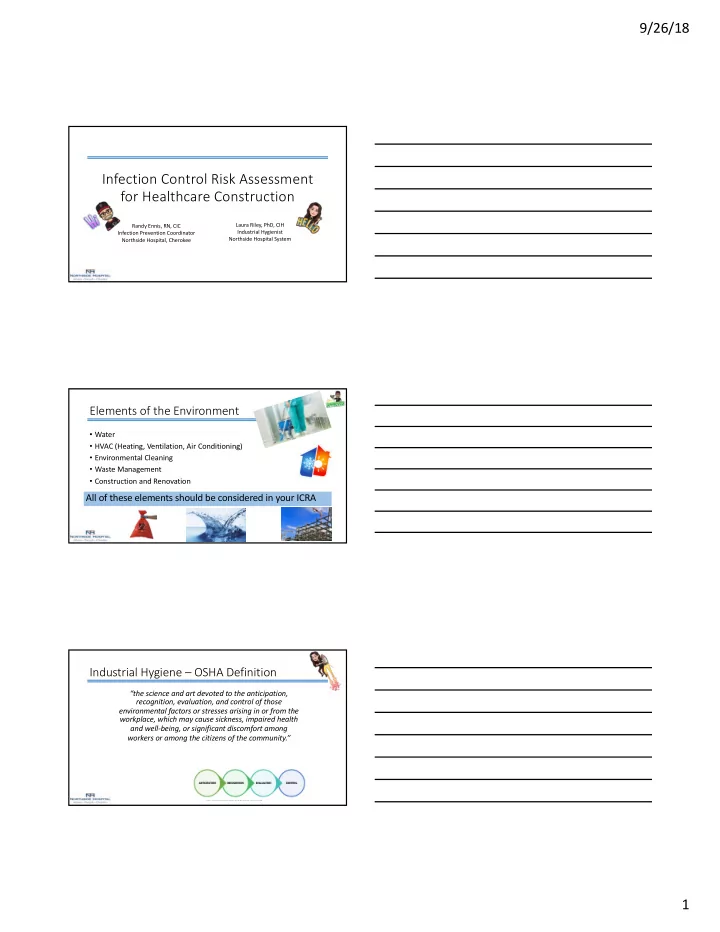

9/26/18 Infection Control Risk Assessment for Healthcare Construction Laura Riley, PhD, CIH Randy Ennis, RN, CIC Industrial Hygienist Infection Prevention Coordinator Northside Hospital System Northside Hospital, Cherokee Elements of the Environment • Water • HVAC (Heating, Ventilation, Air Conditioning) • Environmental Cleaning • Waste Management • Construction and Renovation All of these elements should be considered in your ICRA Industrial Hygiene – OSHA Definition “the science and art devoted to the anticipation, recognition, evaluation, and control of those environmental factors or stresses arising in or from the workplace, which may cause sickness, impaired health and well-being, or significant discomfort among workers or among the citizens of the community.” S o u r c e : h t t p s :/ / w w w .o s h a t r a in .o r g / c o u r s e s / im a g e s / 7 5 0 / 7 5 0 _ in t r o _ s c ie n c e .jp g 1
9/26/18 The Role of an IH • Use environmental monitoring and analytical methods to detect the extent of worker/patient exposure • Employ engineering, work practice controls, and other methods to control potential health hazards • Spot the conditions and help eliminate or control them through appropriate measures Recognizing & Controlling Hazards ICRA - Definition • Determines level of risk to patients and defines controls to reduce risk • 3 step method • Identify type of construction (nature & scope) • Identify patient or staff risk group • Determine the level of infection control classification • Defines the controls that are needed to reduce or eliminate risk to patients 2
9/26/18 The Nuts and Bolts of the ICRA: What are we really doing? • Identifying conditions and factors related to the transmission of infectious disease agents that can be released during construction • Designing and implementing contaminant transmission controls • Continuously evaluating the effectiveness of controls FGI Guidelines 1.2-3.2 - ICRA The following shall be addressed: • Impact of disrupting essential services to patients and employees • The specific hazards and protection levels for each designated area • Location of patients according to their susceptibility to infection and the definition of risks to each • Impact of movement of debris, traffic flow, spill cleanup, and testing and certification of installed systems • Assessment of external and internal construction activities • Location of known hazards Air contaminants generated during construction • Inorganic particles – Aerosols • General construction dusts (sheet rock, fiberglass, wood dust, concrete dust) • Metal fumes and metal dusts • Vapors – adhesives, paints, solvents • Organic particles – Bioaerosols • Fungi – Aspergillus sp., Fusarium sp., Rhizopus sp. • Bacteria – water systems 3
9/26/18 ICRA Players • Multidisciplinary ICRA Team • Infection Preventionist • Construction Coordinator • Facilities Operations • Safety & Security • Environmental Services • Construction Project Manager • Architect ICRA Steps ICRA: Identify Type and Group TYPE Step 1 GROUP Step 2 4
9/26/18 Step 1: Identify the Type of Construction Activity (Type A-D) Inspection and Non-Invasive Activities Includes, but is not lim ited to: rem oval of ceiling tiles for visual inspection only, e.g., lim ited to 1 tile per 50 square o TYPE A feet painting (but not sanding) o o w all covering, electrical trim w ork, m inor plum bing, and activities w hich do not generate dust or require cutting of w alls or access to ceilings other than for visual inspection Small scale, short duration activities which create minimal dust Includes, but is not lim ited to: TYPE B o installation of telephone and com puter cabling o access to chase spaces o cutting of w alls or ceiling w here dust m igration can be controlled Work that generates a moderate to high level of dust or requires demolition or removal of any fixed building components or assemblies Includes, but is not lim ited to: o sanding of w alls for painting or w all covering TYPE C o rem oval of floor coverings, ceiling tiles and casew ork o new w all construction o m inor duct w ork or electrical w ork above ceilings o m ajor cabling activities o any activity w hich cannot be com pleted w ithin a single w ork shift Major demolition and construction projects Includes, but is not lim ited to: TYPE D o activities w hich require consecutive w ork shifts o requires heavy dem olition or rem oval of a com plete cabling system o new construction Step 2: Identify the Patient Risk Group GROUP 1 LOW RISK GROUP 2 MEDIUM RISK GROUP 3 HIGH RISK GROUP 4 HIGHEST RISK Office areas All patient care units not Emergency room Cancer Center/Radiation Areas not engaged with covered under group 3 & 4 Radiology/MRI Oncology patient care activities. Outpatient Areas Post-anesthesia care units Operating rooms; Public Corridors Labor and delivery Sterile Processing Cafeteria Newborn nurseries Labor&delivery OR rooms Dietary Nuclear medicine Cardiac catheterization & Admission/discharge area angiography areas PT – hydro therapy tank Dialysis areas Oncology Units Laboratories Transplant Unit (BMTU) Perinatal Anesthesia High Risk Perinatal Unit All endoscopy areas Microbiology lab Pharmacy admixture All Oncology areas All Intensive Care Units Outpatient invasive procedure rooms Special Care Nursery Depts that care for BMTpatients Infusion Center Radiology Special Procedures Stem Cell Lab We can’t see dust less than 50 um diameter Aspergillus spore diameter about 2 microns 5
Recommend
More recommend